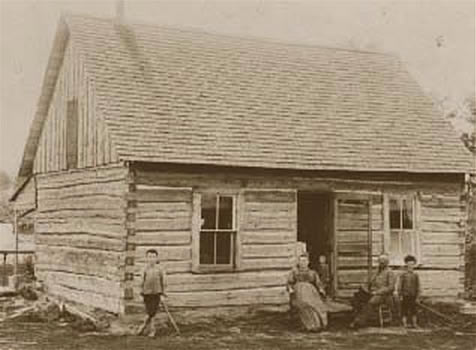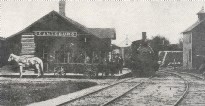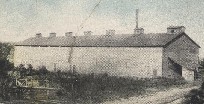UNIVERSITY OF WISCONSIN River Falls
University Archives and Area Research Center
Brief History of Burnett County, Wisconsin
Burnett County's Indian culture dates back more than 8,000 years ago when Woodland Dakota and Ojibwa Indians lived in the area, making use of the natural resources such as berries, game, rice, and maple syrup. Native American families played an important role in the early history of the area and many families continue to live in the county today.
The first white explorers in the area were French trappers and Jesuit missionaries who came to the region from Lake Superior around 1660. Famous French explorer Daniel Greysolon Sieur du Lhut—for whom Duluth, Minnesota, is named—was one of the first to investigate the area in 1678. It was not until the 1850s, however, when Canute Anderson came to settle in Burnett County, that the area started to flourish. Anderson built a farm about four miles south of Grantsburg. The first post office in the county was established at his house and he was appointed postmaster. As many new settlers came to the area, he was there to welcome them. Canute Anderson later built a flour and saw mill, a hotel, and opened a store.
Burnett County was officially established in 1856. What is now Washburn County was once a part of Burnett County, but it split off in 1883. Grantsburg naturally became the county seat because of the trade center. By 1884 a railway was established and by 1886 Grantsburg had a courthouse, school, churches, hotels, stores, and a starch factory.
Another famous settler of the Grantsburg area is "Big Gust," a Swedish man who came to Grantsburg around the turn of the century when he accepted a job as the village marshal. The most unique characteristic about "Big Gust" was his height—7 feet and 6 inches. Even though he was a shy fellow, his height made it much easier for him to enforce the law. There are many stories of "Big Gust" and his law enforcement strategies. When a call was made for "Big Gust" to deal with two drunken men at a local saloon, "Big Gust" took each of them under one arm and carried them towards the jail. There is a life-size carving of Grantsburg's giant policeman near the south edge of town, created by Alf Olson in 1980.
Around the turn of the century, several townships were established and Burnett County increased in population. In approximately 1910, Gustav(e) "Fassauer" Ferron, from Chicago, arrived in Scott Township to settle at what became Ferron Park on Big McKenzie Lake. Ferron was a noted violin maker in Chicago. In addition to regular violins, he also made miniature violins. His violin varnish was quite popular. He was also an amateur archaeologist, especially when investigating the native American burial mounds on his Ferron Park property. His employees caught one of the largest sturgeon in Wisconsin in the lake. He also brought a cigarette-making machine with him. This was a new commodity for the time, as most people still rolled their own cigarettes, which was cheaper than buying them pre-made.
Current areas with an historic theme include the Crex Meadows Wildlife Area and the Forts Folle Avoine Historical Park. The Crex Meadows is a 30,000 acre state-owned wildlife area. The marsh and brush area is home to many different types of wildlife. In the earlier 1900s, the area housed a company that used the grass in the marsh for carpets and twine. The Fort Folle Avione Historical Park area actually dates back over 200 years. In 1969, evidence of an old trading post along the Yellow River was found near Webster. Further excavation of the area turned up remains for two competing trading posts, the Northwest Company Trading Post and the XY Trading Post, which had both operated from 1802-1804. The Burnett County Historical Society later developed the historical park around the two trading posts.
The original courthouse burned in January of 1888. In October of 1888 a new structure was built to replace it. Both of these structures were in Grantsburg. In the early 1980s, the county seat was moved from Grantsburg to Meenon Township (near Siren) and a new government center was dedicated in 1985.
Even today, Burnett County is very scenic with many outdoor activities available to take in the natural beauty. Boating, fishing, snow trails, and camping are just some of the popular things to enjoy in the area. Visitors are always welcome!
Compiled by Elizabeth Heard and ARC staff in 2005, with additions on Ferron kindly provided by Marilyn Gahm in 2015.
___________________________________________________________________________________________________
Sources
Big Gust: Grantsburg's Legendary Giant, written and compiled by Eunice Kanne ([Grantsburg, Wis.]: Grantsburg Area Historical Society, 1989): UWRF ARC F 587 .B95 K3 1989.
Great Scott!: A History of Northern Wisconsin's Earlier Days, Beatric Durand Derrick (Webster, Wis.: The Author, [1965]): UWRF ARC F 587 .B95 D4.
The Heritage Areas of Burnett County (Madison, Wis.: Wisconsin Heritage Areas Program, 1978): UWRF ARC F587 .B95 H47.
Pioneer Tales of Burnett County, compiled by Burnett County Homemakers Clubs, ([Webster, Wis.: University of Wisconsin-Extension Office, 1976]): UWRF ARC F 587 .B95 P56 1976.

Dr. Aker Family Outside Their Cabin in Burnett County, n.d.

Grantsburg Train Depot, ca. 1884

Interior of a Store in Burnett County, n.d.

Grantsburg Starch Factory, 1890s














